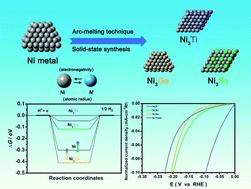当前位置:
X-MOL 学术
›
Dalton Trans.
›
论文详情
Our official English website, www.x-mol.net, welcomes your feedback! (Note: you will need to create a separate account there.)
Exploring the synergistic effect of alloying toward hydrogen evolution reaction: a case study of Ni3M (M = Ti, Ge and Sn) series
Dalton Transactions ( IF 4 ) Pub Date : 2022-06-07 , DOI: 10.1039/d2dt00956k Dong Zhang 1 , Shen-Jing Ji 1 , Yu Cao 2 , Nian-Tzu Suen 1
Dalton Transactions ( IF 4 ) Pub Date : 2022-06-07 , DOI: 10.1039/d2dt00956k Dong Zhang 1 , Shen-Jing Ji 1 , Yu Cao 2 , Nian-Tzu Suen 1
Affiliation

|
In this work, we have demonstrated that one can control the intrinsic activity of Ni metal toward the hydrogen evolution reaction (HER) by simply alloying Ni with different elements (i.e. Ti, Ge or Sn). The HER activities of Ni3M (M = Ti, Ge and Sn) series and Ni metal follow the order of Ni3Ti (η10 = 68 mV) > Ni3Sn (η10 = 122 mV) > Ni3Ge (η10 = 161 mV) > Ni (η10 = 273 mV). After normalizing their HER performances based on the roughness factor (RF), it was realized that Ni3Ti and Ni3Sn both exhibit higher intrinsic HER activities than that of Ni metal while Ni3Ge displays the worst HER performance. This trend was later rationalized by using density functional theory (DFT) calculation, which showed that blending Ni with Ti, Ge or Sn elements will alter the corresponding electronic structure and bonding scheme. Such a change in the bonding scheme (i.e. bonding state or antibonding state) will influence the adsorption energy of the H atom (ΔGHad) on an active site and is the main cause of the synergetic effect that results in the different HER efficiencies of Ni3M (M = Ti, Ge and Sn). Through the present case study, it was recognized that alloying is a simple yet effective strategy to promote the HER activity of an electrocatalyst. With a suitable combination between elements, it helps single metals (e.g. Co or Ni metal) exceed the limits on their intrinsic HER activities and has the potential to replace noble metals (e.g. Pt, Ir and Ru) in the future.
中文翻译:

探索合金化对析氢反应的协同作用:以Ni3M(M = Ti、Ge和Sn)系列为例
在这项工作中,我们已经证明可以通过简单地将 Ni 与不同元素(即Ti、Ge 或 Sn)合金化来控制 Ni 金属对析氢反应 (HER) 的本征活性。Ni 3 M (M = Ti, Ge, Sn)系列和Ni金属的HER活性依次为Ni 3 Ti ( η 10 = 68 mV) > Ni 3 Sn ( η 10 = 122 mV) > Ni 3 Ge ( η 10 = 161 mV) > Ni ( η 10 = 273 mV)。根据粗糙度因子 (RF) 对它们的 HER 性能进行归一化后,发现 Ni 3 Ti 和 Ni 3Sn 都表现出比 Ni 金属更高的固有 HER 活性,而 Ni 3 Ge 表现出最差的 HER 性能。这一趋势后来通过使用密度泛函理论 (DFT) 计算得到合理化,这表明将 Ni 与 Ti、Ge 或 Sn 元素混合会改变相应的电子结构和键合方案。键合方案(即键合状态或反键合状态)的这种变化将影响 H 原子在活性位点上的吸附能(Δ G Had),并且是协同效应导致不同 HER 效率的主要原因。镍3M (M = Ti、Ge 和 Sn)。通过本案例研究,人们认识到合金化是促进电催化剂 HER 活性的一种简单而有效的策略。通过元素之间的适当组合,它可以帮助单一金属(例如Co 或 Ni 金属)超越其固有 HER 活性的限制,并有可能在未来取代贵金属(例如Pt、Ir 和 Ru)。
更新日期:2022-06-07
中文翻译:

探索合金化对析氢反应的协同作用:以Ni3M(M = Ti、Ge和Sn)系列为例
在这项工作中,我们已经证明可以通过简单地将 Ni 与不同元素(即Ti、Ge 或 Sn)合金化来控制 Ni 金属对析氢反应 (HER) 的本征活性。Ni 3 M (M = Ti, Ge, Sn)系列和Ni金属的HER活性依次为Ni 3 Ti ( η 10 = 68 mV) > Ni 3 Sn ( η 10 = 122 mV) > Ni 3 Ge ( η 10 = 161 mV) > Ni ( η 10 = 273 mV)。根据粗糙度因子 (RF) 对它们的 HER 性能进行归一化后,发现 Ni 3 Ti 和 Ni 3Sn 都表现出比 Ni 金属更高的固有 HER 活性,而 Ni 3 Ge 表现出最差的 HER 性能。这一趋势后来通过使用密度泛函理论 (DFT) 计算得到合理化,这表明将 Ni 与 Ti、Ge 或 Sn 元素混合会改变相应的电子结构和键合方案。键合方案(即键合状态或反键合状态)的这种变化将影响 H 原子在活性位点上的吸附能(Δ G Had),并且是协同效应导致不同 HER 效率的主要原因。镍3M (M = Ti、Ge 和 Sn)。通过本案例研究,人们认识到合金化是促进电催化剂 HER 活性的一种简单而有效的策略。通过元素之间的适当组合,它可以帮助单一金属(例如Co 或 Ni 金属)超越其固有 HER 活性的限制,并有可能在未来取代贵金属(例如Pt、Ir 和 Ru)。


























 京公网安备 11010802027423号
京公网安备 11010802027423号